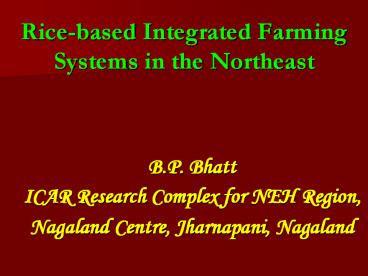Rice-based Integrated Farming Systems in the Northeast - PowerPoint PPT Presentation
1 / 32
Title:
Rice-based Integrated Farming Systems in the Northeast
Description:
Rice-based Integrated Farming Systems in the Northeast B.P. Bhatt ICAR Research Complex for NEH Region, Nagaland Centre, Jharnapani, Nagaland ... – PowerPoint PPT presentation
Number of Views:1347
Avg rating:3.0/5.0
Title: Rice-based Integrated Farming Systems in the Northeast
1
Rice-based Integrated Farming Systems in the
Northeast
- B.P. Bhatt
- ICAR Research Complex for NEH Region,
- Nagaland Centre, Jharnapani, Nagaland
2
Introduction
- In the third world countries, some 2.3-2.6
billion people are supported by agricultural
systems characterized by modern technologies
brought about by the Green Revolution. - These systems utilize good soils and usually have
reliable access to water. However, these systems
are not applicable to the 1.9-2.2 billion
(82.6-84.6) people living in rainfed, undulating
and mountainous areas, which are largely
untouched by modern technologies. - Their agricultural systems are complex and
diverse, and are located in the humid and
subhumid areas, the hills and mountains and the
dry lands of uncertain rainfall. They commonly
produce per unit area only one-fifth to one-tenth
of the food as farms in the industrialized and
Green Revolution lands (Pretty, 1995).
3
Contd.
- Moreover, the green revolution belt of the
country has already reached production plateau
besides leading to environmental hazards and
resultant impact on human health thereby bringing
in increased concerned for sustainability. Such
concerns have given rise to the concept of
evergreen revolution through alternative farming
system methods like organic farming, biodynamic
farming etc. Such farming practices are largely
dependent on organic sources of fertilizer,
recycling of within farm renewable resources and
off farm wastes. - Integrated Farming System (IFS) is based on the
concept that there is no waste, and waste is
only a misplace resource which can become a
valuable material for another product (Edwards et
al., 1986).
4
Opportunities for IFS
- Diverse and complex agricultural systems,
- About 63 rainfed agricultural area,
- Indigenous plant, animal and fish resources,
- Existing agro-biodiversity,
- Availability of animal manure including crop
residues and high biomass production for clean
food production.
5
Components of Rice-based IFS
- Rice-fish integration
- Rice-Livestock farming including poultry and
duckery. - Rice-fish-azolla farming
- Multipurpose trees and shrubs
- Hedgerow intercropping
- Variety of other crops like seasonal vegetables,
medicinal herbs, and potential wild edibles.
6
Rice Production Scenario in NE Region
Source- Basic Statistics of North Eastern Region
Various State Departments
7
Livestock and Poultry Population (million) in
North Eastern States
Source Basic Statistics of North Eastern Region
8
Projected green and dry fodder requirement of
livestock of Northeast
9
Projected dung production (million tonnes/yr)
10
Nutrient content (? S.D.) in some important
organic manures
11
Important Rice based IFS in NE States
- Rice-fish
- Rice-fish-azolla
- Rice-fish-cattle
- Rice-fish-pig
- Rice-fish-goat
- Rice-fish-duck
- Rice-fish-poultry
12
Potential farming system of Apatani Plateau,
Subansari District, Arunachal Pradesh (wet rice
cultivation with indigenous knowledge of land and
water management, forestry and fishery)
13
Pani Kheti system in Phek District of Nagaland
14
(No Transcript)
15
Rice with integrated fish farming in farmers
field
16
Rice-fish-pig IFS in farmers field
17
Rice-fish-cattle IFS
18
Rice-fish cum duck system
19
Growth performance of livestock/birds (kg/animal)
in IFS and traditional animal husbandry practices
Figures in parenthesis represents daily weight
gain (kg/animal/month).
20
Annual feed consumption by livestock/birds in IFS
21
Fish Productivity in IFS (q/ha basis)
Stocking density was 34, 100, 700, 500 and 17 per
ha to pig, goat, duck, chicken and cattle,
respectively. The dressing was 75, 56, 58, 70,
respectively to pig, goat, duck and layer
chicken.
22
Fertilization of fish ponds (Kg/yr) by faecal
material in IFS
23
Growth performance of hedgerow species in IFS
24
Production of Pruned Biomass (q/ha- FW basis)
25
Growth of Indigofera tinctoria as hedgerow species
26
Crop productivity (q/ha) under IFS, Meghalaya
27
Contd.
28
Economic status of different rice based
integrated farming systems
29
Contd.
30
Constraints in adopting the improved agricultural
technologies
- Land ownership and land tenure system.
- Jhum being integral component of the cultural
ethos of the people of NE. - Different agricultural practices of different
ethnic groups. - Inaccessibility
- Poor extension of the proven technologies of
agricultural production.
31
Future Strategies
- Restoration of degraded lands.
- Efficiency use of natural resources for increased
production. - Resource conservation.
- Increased production under upland ecosystem and
crop intensification in lowlands. - Water security
32
Thanks































